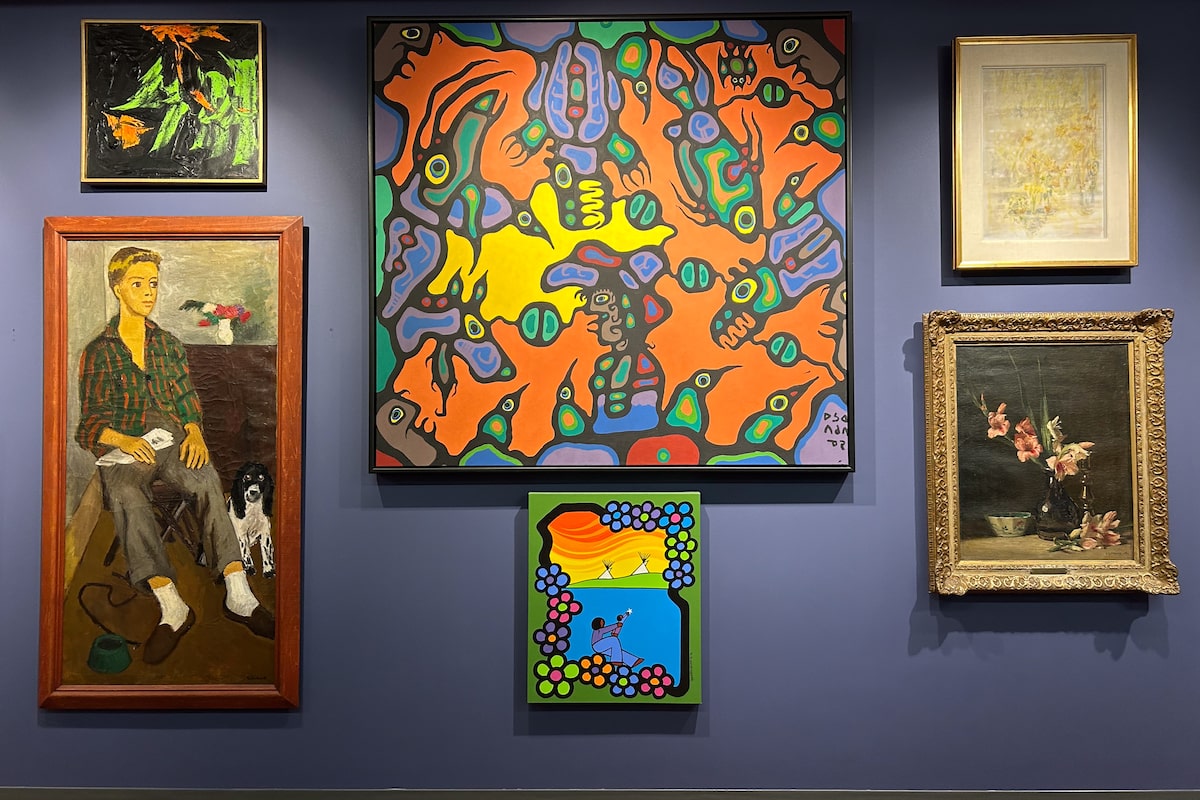
A likely fake painting by Norval Morrisseau hanging at the Visible Storage Gallery in the McLennan Library at McGill University in Montreal in January, 2024.Alexis Aubin/The Globe and Mail
McGill University says its own investigation has concluded it is likely in possession of a painting falsely attributed to prominent First Nations artist Norval Morrisseau.
The probe was first announced in February, 2024, after The Globe and Mail reported on skepticism about the authenticity of artwork at McGill on the heels of a massive fraud where fakes were attributed to Mr. Morrisseau.
In March, 2023, the Thunder Bay Police Service and Ontario Provincial Police said there were between 4,500 and 6,000 fraudulent paintings attributed to the late artist and residential-school survivor. The value of the fraud is estimated at around $100-million.
Mr. Morrisseau, who was also referred to as the Picasso of the North, died in 2007 after becoming one of Canada’s most acclaimed artists. His work featured a style that came to be known as the Woodland School. First Nations leaders say his paintings, often displayed in prominent buildings and institutions across the country, have been instrumental in helping to explain their history.
In response to The Globe’s queries, Gwendolyn Owens, the director of McGill’s visual arts collection, said Friday that the university’s investigation led McGill to believe the piece “is not an authentic artwork by Norval Morrisseau.” The university involved an art history student, Isabelle Hawkins, who worked on the review under the supervision of Ms. Owens.
The painting, known as Shaman Surrounded by Ancestral Spirit Totems, was donated to the university in 2013 with documentation saying it was painted by Mr. Morrisseau, Ms. Owens said.
“The artwork has been removed from public view but remains available to researchers,” she said. “We would like to thank all the scholars, collectors and professionals who supported us and helped make new evidence available.”
Ms. Hawkins publicly described how part of her work included obtaining agreed statements of facts from the criminal proceedings of individuals who pleaded guilty to their roles in the fraud, Gary Lamont and David Voss. After examining images, she said she discovered “the abnormal elements in Shaman Surrounded by Ancestral Spirit Totems were common in Voss’s work.”
“In my opinion, Shaman Surrounded by Ancestral Spirit Totems is not an authentic artwork by Morrisseau,” she said.
Jason Rybak, an inspector with the Thunder Bay police who was a lead investigator on the Morrisseau fraud, told The Globe on Friday that McGill is “another victim in a long list of institutions and private citizens who’ve been taken advantage of” through the fraud.
He said police do not plan to seize the painting because their investigation is complete. It will be up to the university to determine next steps on what it does with the piece, he added.
Last year, Insp. Rybak said the painting, which was on display at the university’s McLennan Library, had characteristics consistent with others that were part of the police investigation called Project Totton.
The Globe has been reporting for more than a year on fake paintings displayed in prominent public institutions, such as a piece taken down at the Ontario Legislature after questions were raised about the authenticity of that painting, called Salmon Life Giving Spawn. The National Capital Commission, a federal Crown corporation, also announced it was working with police after The Globe reported on concerns about a painting called Circle of Four.
Both Salmon Life Giving Spawn and Circle of Four were used as evidence in the police investigation and later appeared in an agreed statement of facts for Mr. Voss, who pleaded guilty last June for the central role he played in the forgeries. He was sentenced to five years in prison.
In December, 2023, Mr. Lamont, pleaded guilty to his role and received a five-year sentence.
The scope of the fakes has contributed to calls, including from Insp. Rybak, for the creation of a national art-crime team, akin to the FBI’s art-crime unit, because art experts say the issue is often associated with organized crime and money laundering. Insp. Rybak has said art crime is a global issue and Thunder Bay police, for example, do not have the resources to track down suspected fakes in places such as Germany and China.
There are no public plans for the RCMP to create an art-crime division despite calls from individuals who study art crime and who want this issue to be taken much more seriously.
Lawyer Jonathan Sommer, one of the individuals who has worked for many years to expose the Morrisseau fakes, has said the fraud grew much bigger than it should have because Canada does not have a dedicated art-crime division. He was among those who raised concerns about the authenticity of McGill’s painting.
Mr. Sommer, who co-runs a company called Morrisseau Art Consulting Inc. with researcher John Zemanovich, has said the scope of the fraud should encourage collectors to take a more pro-active approach. He has also said it would be a mistake for anyone to assume police have resolved all the Morrisseau fraud issues.
